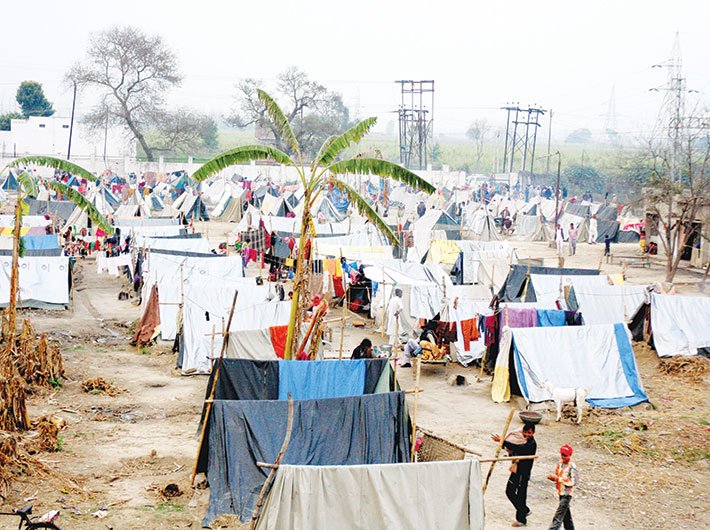The region voted for BJP after Muzaffarnagar riots, but it may revert to regional parties
On the second anniversary of the Muzaffarnagar riots, signs are visible about the second-phase of caste-communal polarisation at work in western Uttar Pradesh. In the 2014 Lok Sabha polls, the BJP was the main beneficiary of the Hindu-Muslim riots (August-September 2013).
The early indications for the 2017 UP assembly elections, however, are that the majority of voters from western UP would rally behind the Mayawati-led BSP. Given the fact that the Hindus constitute about 73 percent of the population in western UP, understanding this recent shift in the mindset of Hindu voters – especially Jats, the most dominant caste there, and OBCs like Jhinvar and Kashyap – is important for the future of politics in the state.
For a long time the most influential party in western UP was the Ajit Singh-led Rashtriya Lok Dal (RLD). But the Hindu community felt betrayed by Singh because he failed in getting the Jat community, to which he belongs –and from which hundreds of men were implicated and jailed – ‘justice’ after the riots, though he was a minister in the UPA government. In Lok Sabha polls, the RLD lost all of the eight seats it contested in alliance with UPA. Singh himself lost the Baghpat constituency to a first-time candidate from BJP.
The Samajwadi Party, which came to power in the state in 2012, completely failed to control the riots, and was expectedly punished by the voters. (SP also has a reputation of being a Yadav-Muslim party, and therefore many non-Yadav Hindu castes despise it.) Significantly, too, in the riots it was the lower castes – like Kashyaps (OBC) and Bhangis (dalit) – who suffered the most, especially the dalits. The polarisation that followed was on religious lines in which all Hindu castes voted against a common ‘enemy’: Muslims. This is why the dalits in 2014 didn’t vote for BSP but for BJP. The Congress never stood a chance because its prime ministerial candidate Rahul Gandhi couldn’t project himself as a hero or a saviour in this polarised environment.
The hero myth created around BJP’s Narendra Modi, his humble background, his rise as CM of Gujarat and later as ‘Vikas Purush’ of Gujarat, worked wonders. He was seen as simultaneously fighting three forces of ‘evil’: the Indian Muslim population; the Congress; and underdevelopment of the country. After the 2013 riots this imagery, of an immediate hero supposedly born to capture the Indian political stage, had become even stronger in western UP: BJP made a clean sweep in the state, winning 73 (including two of an ally) out of the 80 seats.
However, only little more than a year later the disappointment has crept in. The Jats I know from my field work in Muzaffarnagar over the last few years now complain that the BJP has neglected farmers’ issues: Lowering the sugar prices, erratic functioning of sugar mills due to losses, payments not being made to sugarcane suppliers, etc. In Mayawati’s reign, they say, all sugar mills worked on time and payments were delivered on time. The BJP is perceived to have become an ‘udyogapatiyon aur vyapariyon ki party’ (party of industries and traders) and a ‘kisan-virodhi party’ (anti-farmers’ party).
The community had expected the BJP to be tough on Muslims, but is realising that it’s not going to happen. Add to this the March 2015 scrapping of the OBC status of Jats by the supreme court (even though the BJP might have nothing to do with it) and the Jats’ disenchantment with the saffron party is complete. “Purna bahumat wali sarkar kabhi kaam nahi karti (a government with full majority never gets any work done),” remarks Rajendra Singh, a 75-year-old Jat from Purbaliyan village of Muzaffarnagar.
Lesson learnt
The Jats see a renewed hope in Mayawati. In fact, they wish to vote for Ajit Singh’s RLD, provided it enters into an alliance with BSP. Ajit Singh’s traditional constituency comprised of Jats and Muslims of western UP. However, post riots, the Muslims of the region preferred SP over RLD. While Jats punished RLD in the Lok Sabha elections, the party remains a mark of their political identity and they can’t risk rendering it completely irrelevant. RLD supported BSP in the legislative council elections of January 2015, and chances are the two parties might form an alliance.
Jhinvars, the community of landless labourers who are largely dependent on the farmers for their livelihood, are also regretting voting BJP last year. Some of the Jhinvars I talked to expressed similar concerns as Jats, saying they would also vote for the BSP in the assembly elections. The dalits, who had to a great extent deflected to BJP in the name of Hindu unity, are also, due to the lack of any other incentive (economic or otherwise) would most probably go back to the BSP fold in 2017. The Muslims went mostly with SP in Lok Sabha polls, and have no great incentive to shift loyalty for the assembly elections.
To be sure, at the moment no party in western UP has a firm base: The region is vulnerable to polarisation by political parties, as compared to its eastern counterpart, because of its proximity to the national capital and the national media. All the communities are therefore fearful of a riot-like situation before the assembly elections.
A lot rides on the outcome of the assembly elections in Bihar, though: a poor performance by BJP in Bihar might further worsen its prospects in UP elections of 2017, thereby improving the prospects of regional parties – SP and BSP. On the other hand, an impressive performance of BJP in Bihar might have ripple effects on its prospects in the neighbouring state.
But for the time being, Jats of Muzaffarnagar have made up their minds: “Amit (Shah) plus Mulayam (Singh Yadav) is equal to danga (riots),” goes one of their popular new proverbs, “Ajit (Singh) plus Mayawati is equal to badlaav (change).”
(The article appears in the August 16-31, 2015 issue)

